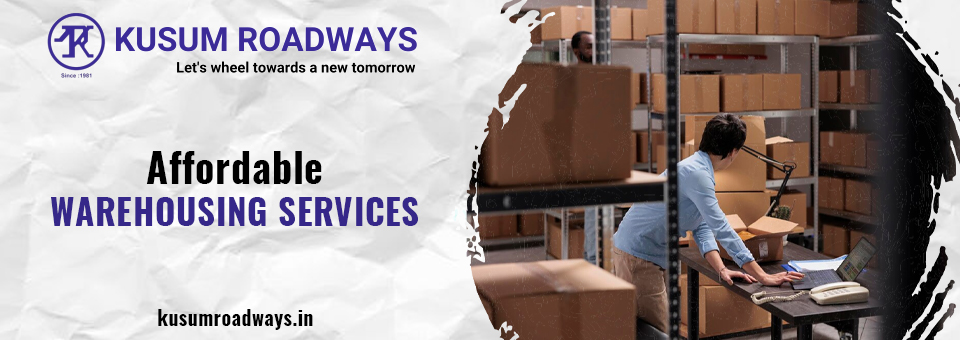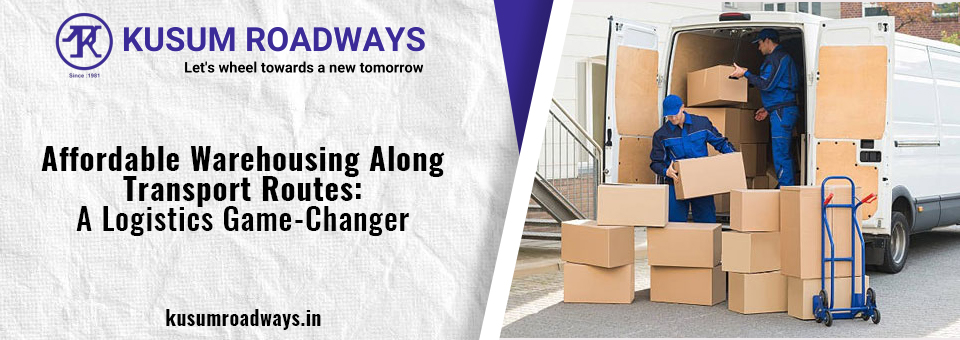- Working Hours 09:00am - 09:00pm
- +91-6376678196
- +91-9437572413
- kusumroadways@gmail.com
Affordable Warehousing Along Transport Routes: A Logistics Game-Changer
safety, security, and environmental standards. Companies need to ensure that their in-transit storage facilities are compliant with these regulations to avoid legal complications and maintain customer trust.
Flexibility Versus Standardisation
While flexibility is one of the primary advantages of in-transit warehousing, achieving a standardised process across multiple locations can be challenging. Companies must strike a balance between tailoring solutions to local needs and maintaining a consistent, efficient system across their entire logistics network.
Future Trends in Affordable Warehousing
The logistics landscape is continuously evolving, and affordable warehousing services along transport routes are no exception. Here are some trends to watch:
Increased Adoption of Green Technologies
Sustainability is becoming a major focus across industries. Future in-transit storage solutions are likely to integrate green technologies—such as energy-efficient lighting, solar panels, and eco-friendly building materials—to reduce their environmental footprint while maintaining cost-effectiveness.
Enhanced Digital Integration
As digital transformation continues to reshape logistics, the integration of advanced software solutions and digital platforms will become even more critical. Expect to see further development in AI-driven logistics management, which will optimise warehouse operations and enhance real-time decision-making capabilities.
Expansion of Modular Warehousing
Modular or flexible warehousing systems that can be quickly scaled up or down based on demand are gaining popularity. These solutions offer businesses the agility needed to respond to sudden changes in market conditions or seasonal fluctuations, further reinforcing the role of in-transit storage as a dynamic component of modern supply chains.
Cross-Industry Collaboration
The future of affordable warehousing services will likely see increased collaboration between different sectors. As industries such as retail, manufacturing, and even healthcare find common ground in logistics challenges, collaborative warehousing facilities that serve multiple sectors could emerge, offering shared solutions that benefit all parties involved.
Bottom Line
Affordable warehousing services along transport routes represent a paradigm shift in how goods are managed during transit. By providing a flexible, cost-effective, and strategically located solution for short-term storage, these facilities address some of the most pressing challenges in mToday’s business environment is fast-paced and competitive, and in this situation, the logistics industry continually seeks innovative ways to streamline operations and reduce costs. One of the most transformative solutions is affordable warehousing along transport routes. These facilities, designed for short-term or in-transit storage, are redefining supply chains by providing a flexible, cost-effective way to handle goods while they move between production, distribution, and retail locations. Through this particular blog, you will come to explore how affordable warehousing services are emerging as a game-changer in logistics, delve into their benefits, examine key considerations, and look toward future trends.

The Evolving Landscape of Logistics
The modern supply chain is a complex network that requires the seamless integration of multiple processes—from manufacturing and transportation to inventory management and last-mile delivery. One significant challenge in this chain is ensuring that goods are stored safely and efficiently during transit. Traditional warehouses, while essential for long-term storage, often lack the flexibility required for the rapid pace of contemporary distribution networks. Affordable warehousing services along transport routes fill this gap by offering short-term storage solutions that adapt to the dynamic needs of logistics. By strategically positioning these facilities along major transport corridors, companies can optimise their distribution networks, reduce delays, and significantly cut costs.
The Role of Warehousing in the Supply Chain
Warehousing has long been a critical element in logistics management. Its primary functions include:
- Storage of Goods: Providing a secure environment for products during periods when immediate distribution is not possible.
- Inventory Management: Helping businesses maintain optimal stock levels and streamline order fulfilment.
- Buffering Against Disruptions: Acting as a safeguard against unforeseen delays, seasonal fluctuations, or demand spikes.
While traditional warehousing remains vital, the demand for more agile storage solutions is rising. In-transit warehousing, often located along transport routes, is increasingly recognised for its ability to provide temporary, yet essential, storage. This flexibility ensures that consignments have a secure stopover point while en route to their final destination, preventing bottlenecks and enhancing overall supply chain resilience.
Understanding In-Transit Warehousing
In-transit warehousing is a specialised form of storage that caters to the brief holding needs of goods during transportation. Rather than being stored for extended periods, products are parked at strategic points along transportation routes. This model is particularly beneficial when:
- Goods Need Temporary Storage: When consignments must be held for a few hours or days before continuing their journey.
- There Are Route Disruptions: In cases where delays or unexpected route changes occur, having a nearby storage facility can be invaluable.
- Facilitating Cross-Docking Operations: Goods are quickly transferred between vehicles, reducing the need for long-term storage.
By offering short-term storage that is both secure and affordable, these facilities bridge the gap between production and final delivery, ensuring that the supply chain remains agile and responsive.
Benefits of Affordable Warehousing Along Transport Routes
Affordable warehousing services along transport routes offer several key benefits that can significantly impact a company’s logistics operations:
Cost Reduction
One of the most significant advantages is the reduction in storage and transportation costs. Traditional warehousing can be expensive due to long-term rental fees and operational overheads. By contrast, short-term, in-transit storage is generally more cost-effective, as it is utilised only when and where it is needed. This approach not only lowers fixed costs but also minimises the need for expensive last-minute arrangements when delays occur.
Increased Operational Efficiency
Short-term storage solutions are designed to be flexible and responsive. They allow logistics managers to adapt quickly to changes in transportation schedules and demand fluctuations. By strategically locating these facilities along major transport routes, companies can reduce the time goods spend idle, ensuring a faster turnaround and improved overall efficiency.
Enhanced Supply Chain Resilience
Supply chains today must be robust enough to handle unexpected disruptions—be it natural disasters, traffic congestion, or sudden demand surges. In-transit warehousing provides a buffer that can absorb these shocks, ensuring that goods are not lost or delayed. This added layer of security and flexibility can be critical in maintaining service levels and meeting customer expectations.
Improved Inventory Management
With affordable, short-term storage, businesses can manage inventory more dynamically. Instead of keeping large quantities of goods in a centralised warehouse, companies can distribute their inventory along key transport routes. This decentralised approach can lead to better inventory turnover, reduced storage risks, and improved responsiveness to market demand.
Strategic Placement: Why Location Matters
The success of in-transit warehousing largely depends on its location. Strategic placement along transport routes is crucial for maximising the benefits:
Proximity to High-Traffic Corridors
Facilities located near major highways, rail lines, and ports enable quick access and reduced transit times. This proximity ensures that goods can be moved efficiently between storage and their final destinations.
Integration with Transportation Networks
Being part of an integrated transportation network allows for seamless coordination between warehousing and delivery. This synergy minimises the time goods spend in transit and reduces the likelihood of delays.
Flexibility and Accessibility
The best in-transit storage solutions offer easy accessibility for a variety of transport modes—whether by truck, rail, or air. This flexibility allows logistics managers to select the most cost-effective and timely transport options based on current conditions.
Enhancing Efficiency and Reducing Costs
Efficient logistics is about more than just moving goods; it’s about optimising every link in the supply chain to create a seamless flow. Affordable warehousing services along transport routes contribute to this efficiency in several ways:
Minimising Idle Time
By providing temporary storage solutions that are situated along critical transport routes, companies can drastically reduce the idle time for consignments. Instead of waiting for a full delivery schedule or extended storage, goods are quickly moved through the system, which translates to faster delivery times and lower holding costs.
Lowering Transportation Expenses
Shorter transit times and reduced detours directly impact fuel costs and driver hours. With strategically placed warehouses, vehicles can take more direct routes and avoid backtracking, leading to substantial savings in transportation expenses.
Reducing Risk of Damage or Loss
The more time goods spend in transit without proper storage, the higher the risk of damage or loss. Affordable in-transit warehousing provides a secure stopover point, ensuring that products are kept safe until they continue their journey. This reliability can result in fewer claims, less insurance expense, and greater overall customer satisfaction.
Technology and Innovations in Warehousing
The integration of technology in warehousing has been a driving force behind the increased efficiency and reduced costs in modern logistics. Several technological advancements are particularly relevant to affordable in-transit storage:
Automation and Robotics
Automated systems and robotics have revolutionised warehousing operations by speeding up inventory handling and reducing manual labour. Automated sorting, picking, and packing systems allow for a quicker turnaround, which is essential for short-term storage solutions where time is of the essence.
Real-Time Inventory Tracking
Modern warehousing facilities are increasingly equipped with advanced tracking systems that monitor inventory levels in real time. These systems provide accurate data and enable logistics managers to make informed decisions about storage durations, transport schedules, and overall supply chain management.
IoT and Smart Sensors
The Internet of Things (IoT) has found significant applications in warehousing. Smart sensors and connected devices provide continuous monitoring of storage conditions, such as temperature, humidity, and security. This level of oversight ensures that goods are stored under optimal conditions, reducing the risk of spoilage or damage.
Data Analytics and Predictive Modelling
With the help of data analytics, companies can predict potential bottlenecks and adjust their logistics strategies accordingly. Predictive modelling tools analyse historical data to forecast demand fluctuations and optimise storage requirements. This proactive approach ensures that affordable in-transit warehousing solutions are utilised to their fullest potential, reducing waste and improving operational efficiency.
Overcoming Challenges in Implementing In-Transit Storage
While the benefits of affordable warehousing services along transport routes are compelling, some challenges need to be addressed:
Infrastructure and Investment
Setting up strategically located warehouses requires an initial investment in infrastructure, technology, and staff training. Companies must carefully assess the cost-benefit ratio to ensure that the long-term savings outweigh the upfront expenses.
Coordination and Communication
Effective in-transit warehousing demands seamless coordination between multiple stakeholders, including transport providers, warehouse operators, and end customers. A lack of communication or misalignment in scheduling can lead to delays, which defeats the purpose of short-term storage.
Regulatory and Security Concerns
Warehousing facilities must adhere to local regulations, particularly concerningodern logistics. From reducing transportation costs and minimising idle time to enhancing supply chain resilience and facilitating rapid delivery, in-transit warehousing is proving to be a true game-changer.
Kusum Roadways offers innovative, affordable warehousing solutions designed for in-transit storage along major transport routes. Specialising in short-term storage, we secure your consignment during transit, ensuring smooth operations and reduced delays. Our dedicated Packers and Movers team prioritises efficiency, reliability, and cost-effectiveness for every customer’s unique logistical needs with excellence. Apart from this service, if you are looking for hassle-free home relocation services, you must contact us today!


